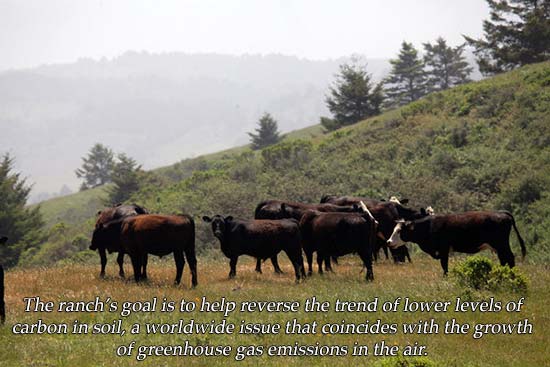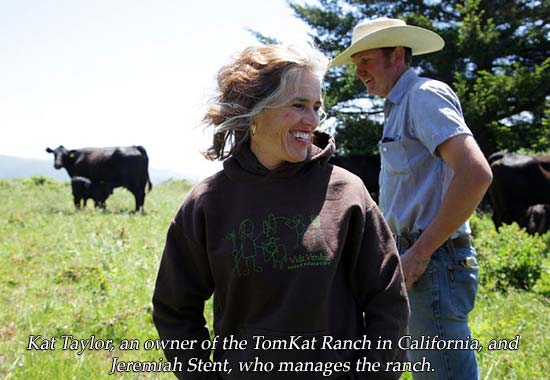An Accidental Cattle Ranch Points the Way in Sustainable Farming

- By STEPHANIE STROM - November 11, 2013 - The New York Times
PESCADERO, Calif. — When Tom Steyer first learned that his wife, Kat Taylor, wanted to sell beef from the cattle herd on their ranch here, he rolled his eyes.
Mr. Steyer is the founder of Farallon Capital, one of the largest hedge funds in the world with some $20 billion under management for universities, foundations and some of the country’s wealthiest people — and he was sure beef was a lousy business investment, particularly on a small scale.

“Practically every year since 1865 has been a bad year for beef,” he said, only somewhat in jest. “And Kathryn” — virtually everyone else calls her Kat — “knew nothing about selling beef.”
Mr. Steyer may have made billions of dollars for his investors before retiring this year, but he would have lost money betting against Ms. Taylor and Leftcoast Grassfed, the brand name of the Steyer-Taylor beef.
While Ms. Taylor says, modestly, that it is hard to know how profitable the business is, her husband said it had outperformed his expectations. “We could sell 10 times the amount we raise, in 10 minutes,” he said.
The couple did not set out to raise prime grass-fed beef at TomKat Ranch, which sprawls across some 1,800 acres in this rural community near the ocean off Highway 1. The plan was to create a model conservation project, demonstrating ways to improve soil health, use solar energy and conserve water. “This wasn’t about cows,” Ms. Taylor said.
But once cows became part of the plan to restore the land, it was not too long before TomKat also became an agricultural project, one that the couple hope will help develop sustainable farming practices that can be put to use far beyond Pescadero.
“Think of the ranch as a huge science experiment,” Mr. Steyer said. “Can you raise animals sustainably? Can the land become the carbon sink that it once was? Can you demonstrate a way of doing agriculture, raising food, that doesn’t damage the environment?
Since his retirement, Mr. Steyer has stepped up his work on environmental causes, creating a national campaign to oppose the Keystone XL pipeline and spending heavily to support candidates around the country whose credentials on environmental issues mesh with his goals.
No statistics are available on the size of the market for grass-fed beef. But in a sign of the growing interest in it, the Agriculture Department this fall began publishing a monthly report on prices for such meat in partnership with the Wallace Center, part of a network of nonprofit groups established by the Rockefellers that work on food issues.
Ms. Taylor has a full-time job as chief executive of One PacificCoast Bank, the community development bank she and Mr. Steyer started. On a sunny spring day this year, she drove out to the TomKat ranch to talk about Leftcoast Grassfed, arriving in a beat-up Toyota SUV together with her constant companions Fang and Ziggy, a wheezy pug and fluffy chow.
She said the ranch’s goal was to help reverse the trend of lower levels of carbon in soil, a worldwide issue that coincides with the growth of greenhouse gas emissions in the air.
In a book, “Grass-Fed Cattle: How to Produce and Market Natural Beef,” the author Julius Ruechel theorized that soil was enriched as a result of the migration of giant herds of ruminants and other animals across the world’s great plains.
According to his book, large herds of heavy, hoofed animals help force dead plant materials back into the ground, where they are broken down by microorganisms in the soil. Herd migration also churns up the earth, allowing rain to penetrate it further and slowing runoff, and natural “fertilizers” containing additional microbes are left in the herd’s wake.
All of that produces more and better grass, which then feeds the herds the next time they migrate across the land.
“The conservation movement now largely says these large, migrating herds aren’t so bad after all,” said Wendy Millet, the ranch director who formerly worked at the Nature Conservancy. “Ranches can be working landscapes if people understand how animals and land work together.”
TomKat is aiming to mimic the migratory patterns that developed the world’s great plains on a small scale by rotating cows, birds and pigs around the ranch in a deliberate dance.
The ranch has been farmed since at least the mid-1800s, when homesteaders named Honsiger contributed their name to a creek on the property that still is home to coho salmon and steelhead. The Honsigers put up barns and houses, orchards and stock ponds that still dot the property, and their descendants have perpetual access to a grave site near its entrance.
In the 1970s, it was owned by an Austrian count and countess, Alfred and Beatrice Von Homola, who used it for family retreats and entertaining. “Then the count died of a heart attack while on a European voyage, and the countess was heartbroken and reportedly couldn’t bear to return to the ranch,” Ms. Taylor said.
The countess leased the property to new occupants who effectively worked it to the bone. “They literally had sold everything, even the topsoil,” Mr. Steyer said. “People came in with dump trucks and carted it away.”
When a friend of Ms. Taylor’s called her about the ranch in 2002, technology titans were snapping up big swathes of property in the area and putting up gates and fences. “He told me if we didn’t buy it, it was going to end up as a housing development,” she said.
Having grown up in San Mateo, Ms. Taylor wanted to keep the ranch as an integral part of the community.
This spring, for instance, silos were installed where nongenetically engineered feeds are stored that can be bought by nearby farmers and ranchers. Such feeds are in scarce supply and thus out of reach of most farmers, but TomKat makes the investment in a bulk buy and then passes on the savings to its neighbors.
The silo is housed at a barn leased to the Early Bird Ranch, a poultry, egg and pig business owned by Kevin Watt and his wife, ShaeLynn.
When TomKat’s herd has finished grazing a pasture and been moved to another spot, Early Bird’s chickens and turkeys move in and dine on the insects that have been attracted to the cattle droppings.
“The bugs are a good source of protein for my birds, and my birds eat up the insects and parasites that are bad for the cattle when they return,” Mr. Watt said. “And of course, they leave a little beneficial deposit behind, too.”
The Watts sell their chickens locally in farmers’ markets and sell eggs, bacon, Italian sausage and other products via a website, goodeggs.com, in the San Francisco market.
Mr. Watt said Early Bird cleared roughly $6 in profit on each bird. Out of that, they make a lease payment to TomKat for the acres they use for their poultry, which rotates depending on where the TomKat herd has been. “It really is a symbiotic system, for the chicken and turkeys and cows as well as for Early Bird and the ranch,” he said.
Similarly, a company devoted to aquaponics, Inka Biospheric Systems, is developing a fish and vegetable business on the ranch. Inka’s goal is to raise the food it needs for its fish, things like barley fodder, earthworms and black soldier flies, using waste manure generated by the horses Ms. Taylor keeps on the ranch.
The vermicompost byproduct Inka produces is used to fertilize more stressed locations on the ranch and made into compost teas that can be spread on the orchards and on livestocks as a natural pesticide.
“We’re the garbage men of the organization,” said Brian Whitney, the recently retired chief executive of Inka. “What we are slowly doing is taking on the waste streams the ranch creates and converting those into assets.”
Inka pays the ranch a portion of its revenue, but its profits, when it starts generating them, will flow into a philanthropic foundation, in the same way that a foundation benefits from the operations of One PacificCoast Bank.
“We want to see if we can create a closed-loop system here — water with fish waste will get pumped into the land, and the land will produce things that go back into the fish,” Ms. Taylor said.
Not everything in the experiment works, of course. The ranch originally bred its herd to deliver calves in the fall on the theory that since most calves are born in the spring, it would be producing fresh beef in the off-season.
But the colostrum in cow’s milk is highest in the spring, when the herd is eating the new grass.
“Nature intended for babies to be born in the spring, and we eventually had to go along,” Ms. Taylor said.
The herd, which started with 30 heifers in 2006, now numbers 120, about half of which are breeding stock. They produced about 60 calves this year.
This article has been revised to reflect the following correction:
Correction: November 11, 2013
An earlier version of this article misstated the subtitle of Julius Ruechel’s book “Grass-Fed Cattle.” It is “How to Produce and Market Natural Beef,” not “How to Raise and Market Natural Beef.” Also, an earlier version misspelled the formal first name of Kat Taylor, an owner of the TomKat Ranch. It is Kathryn, not Katherine.


